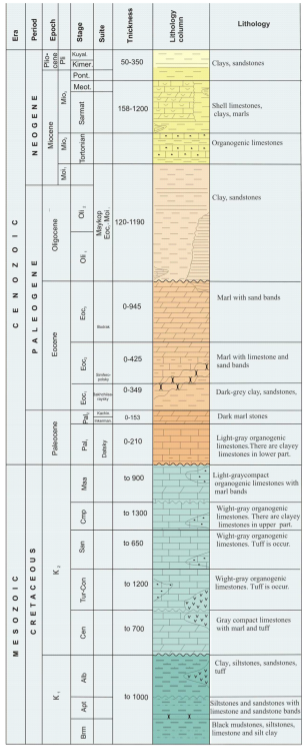The most ancient sediments of the north-west shelf of the Black Sea are related to Archean and Proterozoic metamorphic rocks and intrusive basement sequences of East European platform. Paleozoic sediments are known on Zmeiniy island and on Lomonosov massive located in 45 km to a south-west from Crimean peninsula.
In the deeper offshore further south, tilted and partly eroded fault blocks of Jurassic and older strata, with possible reservoir and trapping potential, can be expected on the southern flanks of the Kalamytsk High and Krayevaya Spur, as a result of the Aptian-Albian rifting.
Most of the wells drilled to date within the Ukrainian offshore waters have penetrated Cretaceous to Cenozoic sediments some 700-5400 m thick. Lower Cretaceous sediments are represented by clastic units (siltstones, mudstones and sandstones), up to 1200 m thick. The Upper Cretaceous sediments include carbonate sediments, up to 2100 m in thickness.

The Cenozoic sequence (up to 2200 m) is represented by Paleocene, Eocene, Oligocene-Lower Miocene, Middle-Upper Miocene, Pliocene and Recent strata. Limestones and chalky clays predominate on the north-west shelf in the Paleocene strata but shales, chalky clays and limestones with thick bands of siltstones predominate to the east in the Kerch Peninsula. The Paleocene thickness varies from 80-600 m. The Lower Eocene in the offshore is characterized by dark-grey calcareous clays and, less frequently by argillaceous marls. Middle Eocene sediments are represented by limestones and chalky clays 30-100 m to 400 m thick.
Next: Hydrocarbon Source Rocks